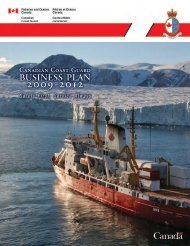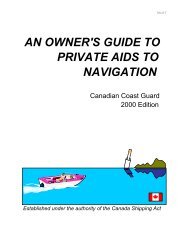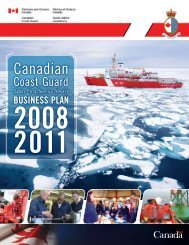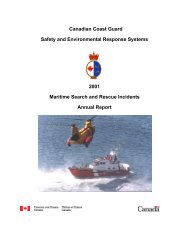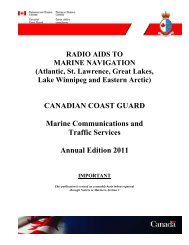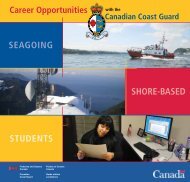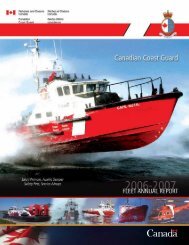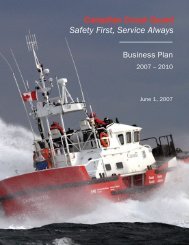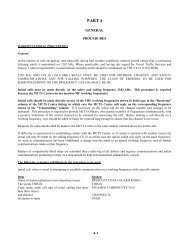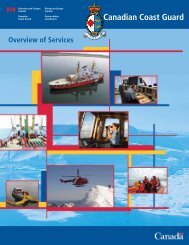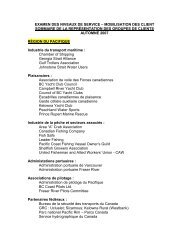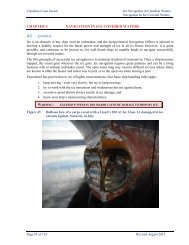RADIO AIDS TO MARINE NAVIGATION - Canadian Coast Guard
RADIO AIDS TO MARINE NAVIGATION - Canadian Coast Guard
RADIO AIDS TO MARINE NAVIGATION - Canadian Coast Guard
Create successful ePaper yourself
Turn your PDF publications into a flip-book with our unique Google optimized e-Paper software.
URGENCY COMMUNICATIONS<br />
The Urgency Signal consists of the words “PAN PAN”.<br />
The Urgency Call consists of:<br />
i) the words “PAN PAN” (spoken three times);<br />
ii) the words “All Stations” or station specific call (spoken three times);<br />
iii) the words “This is” followed by;<br />
iv) the name of the station making the call (spoken three times); and<br />
v) the ship’s MMSI number (if applicable).<br />
The urgency signal shall be transmitted only on the authority of the master or the person responsible for the ship, aircraft or<br />
other vehicle carrying the mobile station.<br />
The Urgency signal indicates that the calling station has a very urgent message to transmit concerning the safety of a ship,<br />
aircraft or other vehicle, or the safety of a person.<br />
The urgency signal, the urgency call, and the urgency message shall be sent on the distress frequencies 2182 kHz and Ch<br />
16 (156.8 MHz). If transmission on these frequencies is impossible, any other available frequency on which attention<br />
might be attracted should be used.<br />
The urgency signal has priority over all other communications, except distress, and all stations which hear it must take care<br />
not to interfere with the transmission of the message which follows the urgency signal.<br />
Stations which hear the urgency signal must continue to listen for at least three minutes. At the end of this period, if no<br />
urgency message has been heard, normal service may be resumed. However, stations which are in communication on<br />
frequencies other than those used for transmission of the urgency signal may continue their normal work without<br />
interruption provided the urgency message is not addressed “to all stations”.<br />
SAFETY COMMUNICATIONS<br />
The Safety Signal consists of the word “SÉCURITÉ”.<br />
The Safety Call consists of:<br />
i) the word “SÉCURITÉ” (spoken three times)<br />
ii) the words “All Stations” (spoken three times)<br />
iii) the words “THIS IS” followed by<br />
iv) the name of the station making the call (spoken three times)<br />
v) the station’s MMSI number (if applicable)<br />
vi) “Safety Message”<br />
vii) “Listen 2638 kHz”<br />
The safety signal indicates that the station is about to transmit an important navigational or meteorological warning. The<br />
safety message should be sent on a working frequency, which is announced at the end of the call.<br />
The safety call is transmitted on the distress frequencies 2182 kHz and Ch 16 (156.8 MHz). If transmission on these<br />
frequencies is impossible, any other available frequency on which attention might be attracted shall be used.<br />
All stations hearing the safety signal shall shift to the working frequency indicated in the call and listen to the safety<br />
message until satisfied it does not concern them.<br />
The Safety Message format consists of:<br />
i) the word “SÉCURITÉ”<br />
ii) the words “All Stations” (spoken three times)<br />
iii) the words “This is” followed by<br />
iv) the name of the station making the call (spoken three times)<br />
v) the details of the safety message<br />
vi) the word “Out”<br />
4-7



